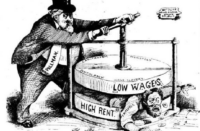September 2017 is the 150th anniversary of the publication of the first volume of Das Kapital (Capital), the central work of Karl Marx (1818–1883) and the book that most influenced social and political thinking ever since. It has especial relevance today, describing, as it does, the labour relations of a capitalism that is reverting to the nineteenth-century forms described by Marx. The sale of Capital increased markedly in his native Germany and elsewhere in 2008 with the emergence of international capitalism’s latest crisis.
Capital is a dense and difficult read for most people. The more accessible Communist Manifesto, jointly written with Frederick Engels (1820–1895) in 1848, is a propagandist tract for educating workers involved in class struggle. Capital has a more ambitious aim: to expose the inner workings of capitalism.
Marx decided that this needed a rigorous approach, like those of Adam Smith and David Ricardo, rather than that of utopian socialist texts, such as those of Robert Owen or Henri de Saint-Simon. Capital was his weapon for attacking the bourgeoisie, exposing how one part of the population exploits another.
As most workers were ill-prepared for understanding Capital, Karl Kautsky (immortalised by Lenin as “the Renegade Kautsky”) presented Marx’s principal ideas in a more accessible form in The Economic Doctrines of Karl Marx (1887). This interpretation of Marx, along with the Manifesto, hegemonised the working-class movement during its Second International phase (1889–1914) and became the doctrine of contemporary social-democratic parties, the Third International (1919–1943), and the Soviet Union.
Marx himself never mentioned “historical materialism,” nor “dialectical materialism,” both posterior constructs of Engels and others, who tried to offer the working class Marx’s achievement in a more digestible form.
Capital contains elements that don’t cohere fully and that depend on understanding the historical context in which they were written. This happens in other areas of investigation. Einstein presented his theory of special relativity in 1905 and his theory of general relativity in 1915; in between he published texts that failed to resolve problems raised by his concept of special relativity.
Nobody today would try to vindicate those early failures. But the criteria to be met in order to achieve consensus in the social sciences, to which Capital belongs, are epistemologically far looser than in the physical sciences. However, Engels held that, “as Darwin had discovered the laws that govern the development of organic nature, Marx discovered the laws that govern the development of human history.”
Darwin’s influence, allied to Hegel’s theory of historical development, suggested to Marx a historical scheme to which, in theory, every society conformed. Feudalism would be followed by capitalism, which evolves into socialism.
The later Marx was to modify this schema. In the 1870s, studying the social evolution of “backward societies,” he offered the opinion that this could never be understood through the “universal passport of a general historical-philosophical theory, whose supreme virtue resides in its being suprahistorical.” He thus amended the “laws” of historical development that Engels had systematised as historical materialism.
As the 1917 revolution occurred in an almost feudal Russia, Antonio Gramsci (1891–1937) called it a “revolution against Capital.” He wrote: “Capital was, in Russia, a book of the bourgeoisie since it . . . initiated a capitalist era, not one in which the proletariat seized power.” The Bolshevik revolution “rejected Marx when it showed that the canons of historical materialism are not as firm as one . . . had thought.”
What Gramsci really showed is that orthodox Marxism belongs, epistemologically speaking, to social science, where total consensus is impossible.
In both Capital and the Communist Manifesto the struggle between two basic classes, capitalist and worker, underlies historical development, as if the structure created by the economic system exists first, and then real people, who “make their own history, but not as they will it under circumstances chosen by them, but under circumstances they encounter directly, but which exist as a legacy of the past,” occupy it. Therefore class is the only objective reality which varies according to the development of the productive forces.
In his analysis of the coup d’état of Louis Bonaparte in 1851, however, Marx diagnosed a much more complex network of social groupings. Thence, according to Lenin, social classes are also social constructs that depend on practical politics and not simply gaps in the relations of production.
However, the Marx of Capital believed that capitalism’s dynamic involved the destruction of all social classes except those of the workers and capitalists. According to him, the complexity of real life is simplified by the development of capitalism itself, which gradually augments the number of workers as it reduces simultaneously the number of capitalists.
This idea, taken up later by Kautsky, had to deal with capitalism’s transformations at the end of the nineteenth century and the appearance of the middle classes. This debate is crucial to understanding contemporary social phenomena and politics.
Marx’s writings skirt the environmental and feminist questions. While some contemporary Marxists assign him such sensibilities, both he and Engels were men of their time, with almost inevitable patriarchal tics. To get a Marxist view on environmental and feminist concerns, the reader must consult the work of modern Marxists, who bring new sensibilities and information to bear on their work. Another notable lacuna persists: a convincing left analysis of nationalism and a tendency of many socialists to conflate it always with regressive political tendencies.
However, Capital is a necessary corrective to an intellectual drift that vitiates contemporary Marxist analysis: the tendency to ignore material and economic considerations in political analysis. The founders of “scientific socialism” centred their attention on political economy and its economic base; most twentieth-century researchers concentrated almost exclusively on superstructural matters, especially cultural questions.
The tone of these studies drifted from an optimism based on the assumed validity of Marx’s initial conception of history to a pessimism deriving from the failure of brute facts to conform to his original scheme. Also, the fact that the original Marxist intellectuals were political leaders but increasingly, from the 1920s onwards, were academics led to a disconnect between the organised working class and the former.
Finally, the welfare state, born of a compromise between capital and labour, caused many working-class activists to question the need for socialism.
So, in the post-war years, especially after the fall of the Berlin Wall, few wanted to study Capital. The book appeared to have little relevance to everyday life, appearing to describe a crude nineteenth-century capitalism.
But today, Capital describes a capitalism in which labour relations revert to those of the nineteenth century, thus bearing out Marx’s prognosis. Company restructurings implicate thousands of workers internationally; the global economic and environmental crises deepen; and the depredations of financial capitalism take various forms.
So, while Capital may not be the key that opens all doors, by teaching us the basics of class and social inequality it is simply the best guide to understanding the world we live in, and the politics needed to change it.





